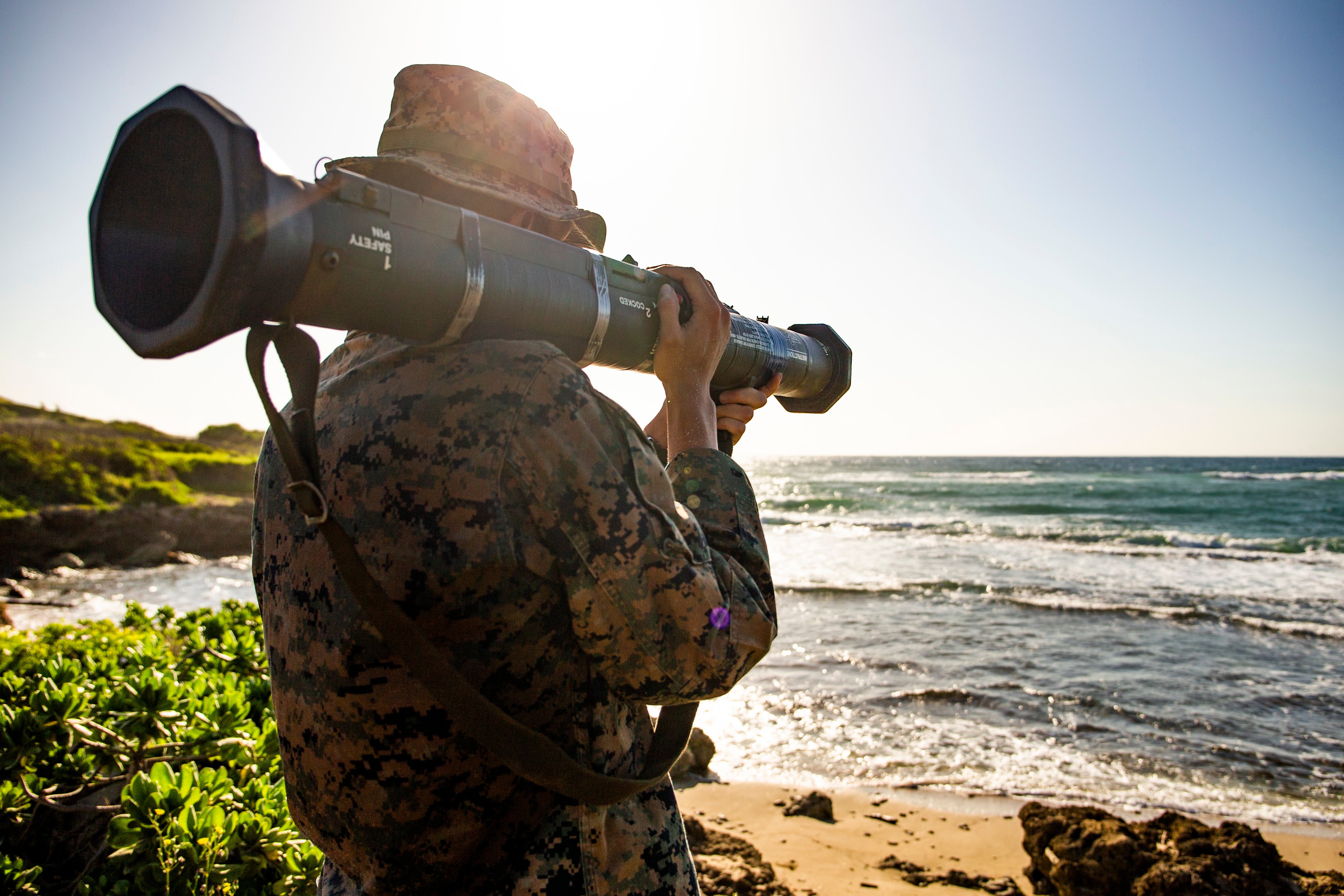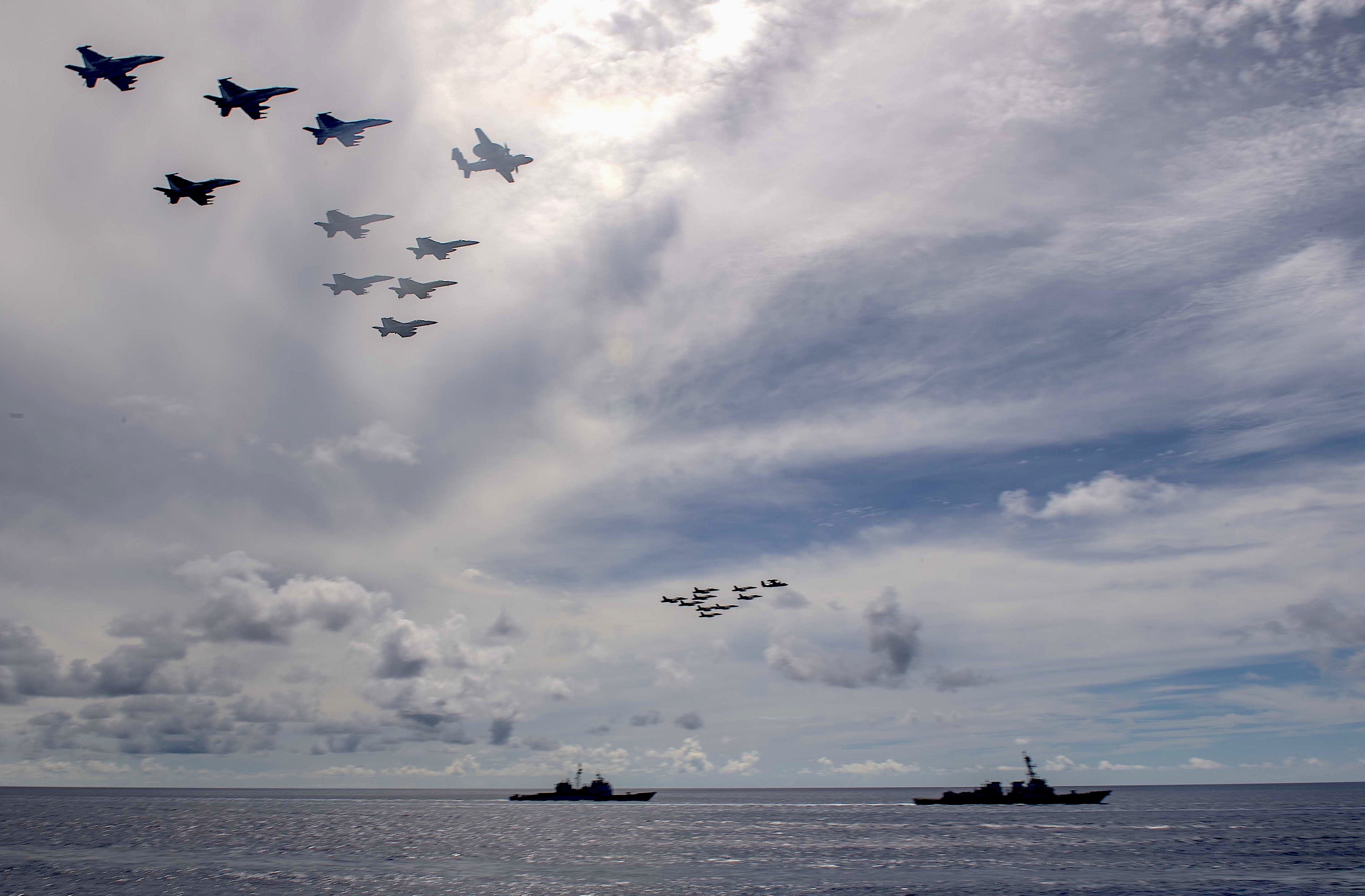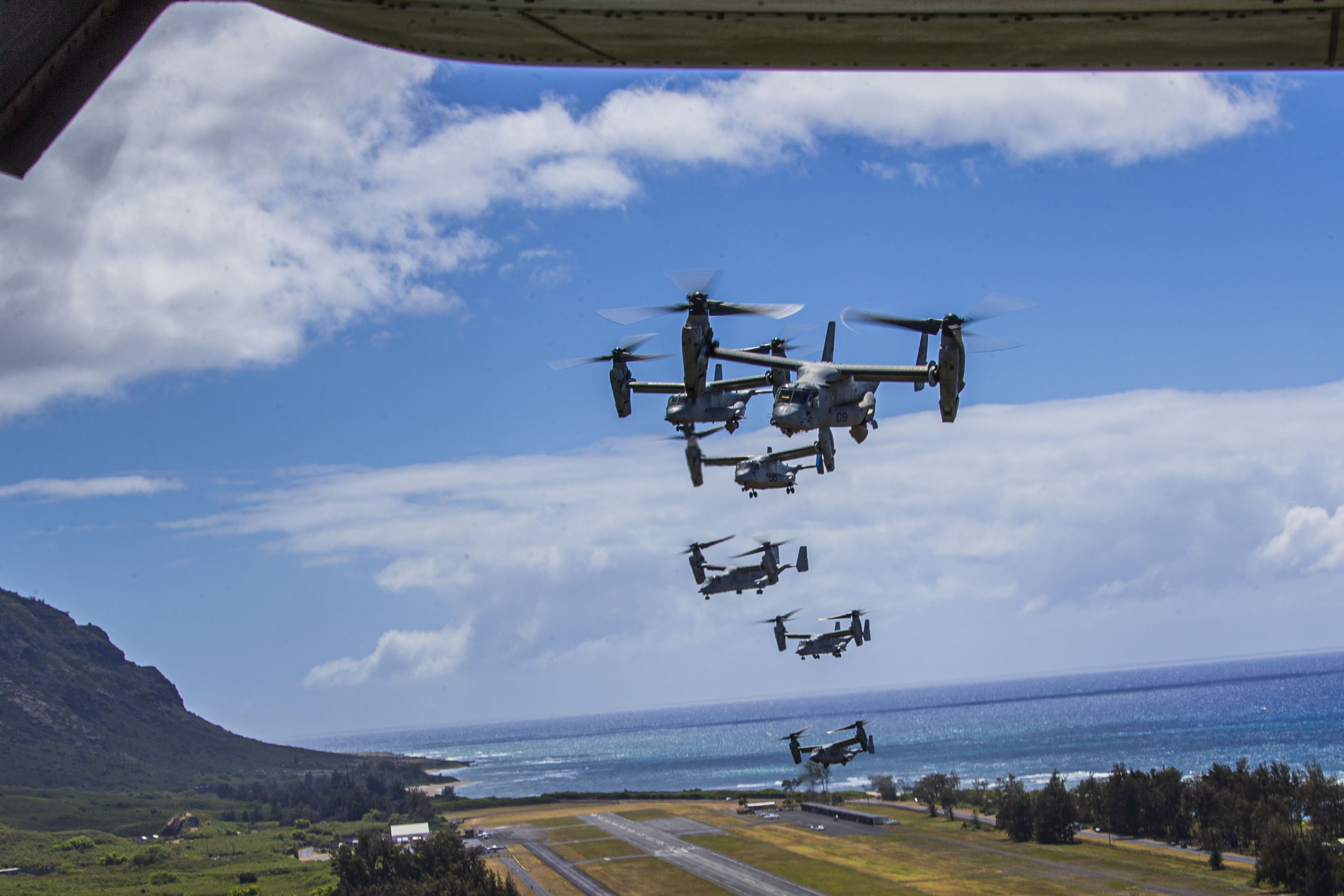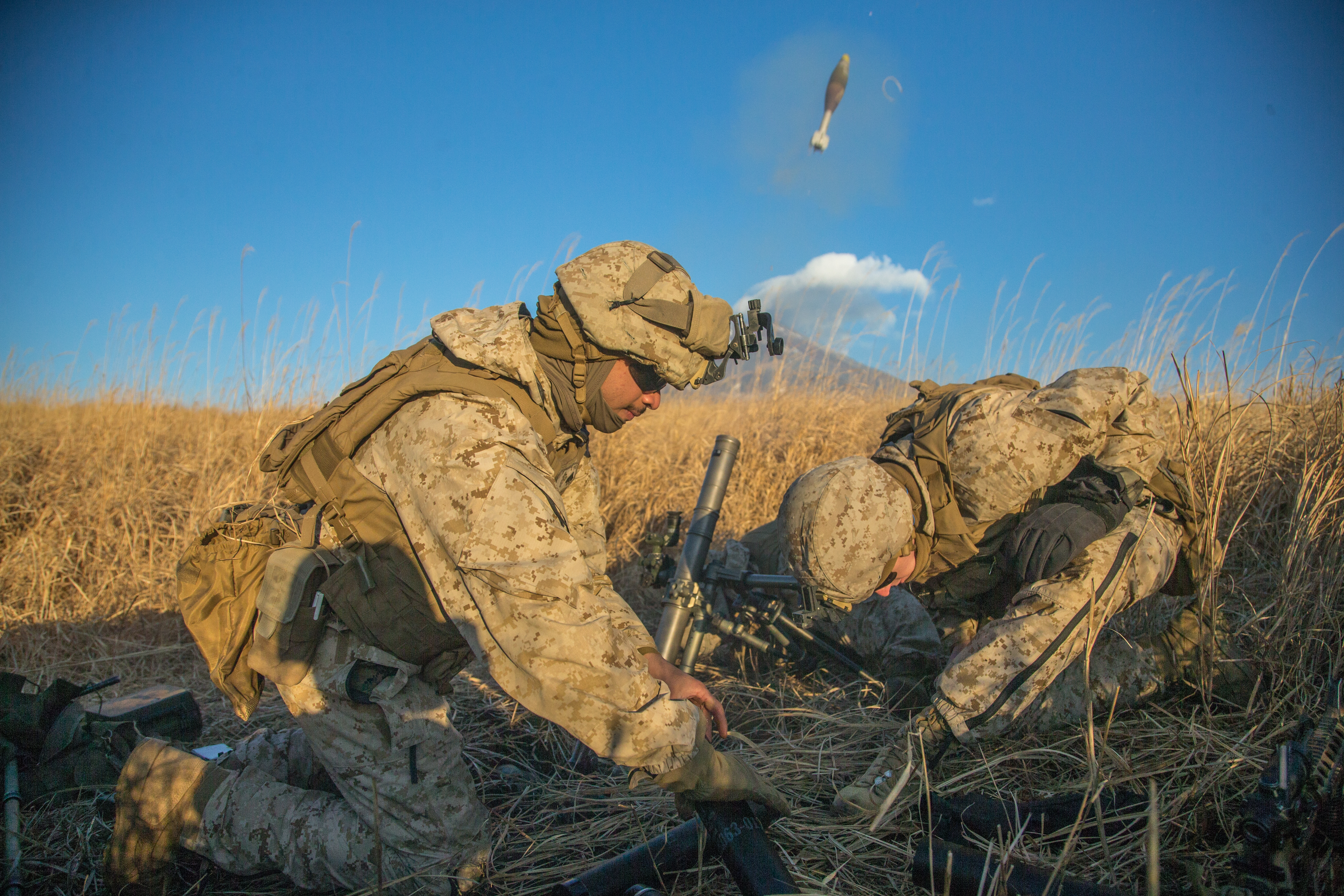
The chief of naval operations and commandant of the Marine Corps say they are increasingly clear on how they’d want to fight a peer adversary, what attributes would make their forces successful and what platforms they need to equip that force. Now, they just need help from Congress turning that into a budget everyone can agree upon, they say.
Chief of Naval Operations Adm. Mike Gilday said the Navy and Marine Corps put significant thought and analysis into their 2020 future force design work, which was ultimately approved by former Defense Secretary Mark Esper and his team at the Pentagon before the 2020 election. Though the naval services are working with new Pentagon and White House leadership now to again make their case, Gilday said he was confident that the analysis holds up and points the services in a clear direction that the executive and legislative branches should help support.
“I think what the analysis gave us, besides a number [of ships] north of 355 … it actually gave us a better understanding of what the composition of the fleet needs to be based on how we think we’re going to fight. It gave us a better understanding of what we need to fight with in terms of capabilities and platforms,” he said Thursday at the annual McAleese FY 2022 Defense Programs Conference, adding that that includes not just the ships and planes but also new missiles and directed energy weapons, unmanned systems in all domains, and more.
Additionally, every carrier strike group or amphibious ready group that goes out on deployment helps conduct “fleet battle problems that rigorously test an aspect of those operating concepts,” Gilday said of Distributed Maritime Operations (DMO), Littoral Operations in a Contested Environment (LOCE) and Expeditionary Advanced Base Operations (EABO), which he said he views as all being nested together.
“We’ve been doing that for four or five years now. I think we have a really good understanding of how we’re going to fight, and that has really paid dividends in terms of informing what we’re going to fight with.”
Still, he’s struggling to get Congress to go along with his plans to achieve that budget.
Though Gilday did not discuss the upcoming Fiscal Year 2022 budget request, it’s widely believed that the Navy will request to decommission many of its Ticonderoga-class cruisers early to free up money and manpower for higher-priority missions and to invest in technologies to support the future fleet design. Lawmakers on the House Armed Services seapower and projection forces subcommittee, including HASC vice chair Rep. Elaine Luria (D-Va.) and seapower subcommittee ranking member, Rep. Rob Wittman (R-Va.), have already said they do not support the idea of divesting current ships to free up money to invest in future capabilities.
HASC Chairman Rep. Adam Smith (D-Wash.) didn’t weigh in on the cruisers specifically when asked by USNI News at the event about the Navy’s divest-to-invest strategy, but he did say that the services would have to find money within their own budgets to help pay for modernization. He added that parochialism from lawmakers with naval ties in their home districts may be playing an outsized factor in the resistance to the plan, whereas the Marines’ divest-to-invest plan has seen much less pushback.

Gilday said the Navy is focused on fielding the most lethal and ready force it can with whatever top line Congress gives them.
He believes the plan put forward last year – which was approved by Esper after significant input from the shipbuilding and repair industry, think tanks, academia and more – will get the Navy there, but it relies on reaching a 355-ship fleet with a certain balance of retaining today’s ships versus divesting of old ships to pay for new ones.
If “you still want to be on a path to 355, but to do that you want to do it on the back of the legacy fleet, I think that’s a whole different conversation in terms of what the cost would be,” Gilday said.
The CNO said that, based on recent funding levels, an appropriate near-term fleet size would be 300 to 305 ships. To sustain a fleet of that size, he’s made investments in filling 25,000 additional billets to support operations, in filling weapons magazines that had previously sat empty, and in upgrading IT infrastructure and accelerating migration to the cloud.
“From a wholeness perspective, 300 to 305 is my sight picture right now in order to have a navy that’s sustainable. What I don’t want to do is get to a place where – if for example, if somebody’s strategy is, keep everything that you’ve got, buy as much new as you can – it’s easy to make those assertions, but they have to be fiscally informed – or, if we’re forced to keep everything that we have, if we’re forced to buy as much new as we can, the money’s going to have to come from somewhere inside that budget. And even though the Navy has found $40 billion across the [five-year Future Years Defense Program] in some of our reform efforts last year, and we’re putting $7 billion towards shipbuilding as an example this year, that’s not a recipe for success in the long term in terms of maintaining a healthy fleet,” Gilday said.
“And what I get concerned about, when people talk about just keeping everything that you’ve got and buying as much as you can, is that the risk is going to be driven down, and we’ve seen this before, on our O-5 level COs, on our commanders of those ships and their crews. And so every decommission for me, sir, is a very, very deliberate decision, in terms of warfighting capacity, what we’re giving up, what we potentially gain from that.”
He noted that there’s been pushback over the idea of decommissioning cruisers, but just this spring USS Vella Gulf (CG-72) missed the beginning of its deployment because it twice had to return to its homeport to get cracked fuel tanks fixed.
He also noted pushback to decommissioning the first four Littoral Combat Ships, which were built to somewhat different configurations than the rest of the class and haven’t received any hull or combat system upgrades since construction. They’d need about $2.5 billion in improvements if the Navy were going to make them combat-ready, and Gilday said he’d rather spend that money investing in new frigates instead.

Gilday told USNI News during the event that the Navy and Marine Corps had a good idea of how they’d conduct DMO, LOCE and EABO operations after significant work at the fleet level on naval integration and concept development, informed in part by the fleet battle problem events conducted by CSGs and ARGs.
He said he was impressed by the level of naval integration happening between U.S. 3rd Fleet and I Marine Expeditionary Force in California, and U.S. 7th Fleet recently briefed him on how they’d use the concepts to operate with Marines in support of recently updated U.S. Indo-Pacific Command war plans.
The CNO said he’s “very, very bullish on Navy-Marine Corps integration, the flexibility that EABO gives us with respect to sea control, sea denial and power projection. So I would tell you that I’m very optimistic … with respect to the tempo and the pace that we’re getting after it operationally.”
This level of understanding the concepts “won’t make tough decisions any easier, but it will help us, I think, to make better-informed decisions on where we’re going to put that next dollar” in the budget – and certainly some of that money would go to amphibious needs, he said.
Commandant Gen. David Berger spoke at the conference just after Gilday and said the focus of his Force Design 2030 effort was to help deter a fight with China and to help compete with them on a day-to-day basis in the gray zone, where China is “eating our lunch” today.
“Part of that is because they play by a different set of rules. They’re blurring the lines between police forces and coast guard and military and politics – they are blurring that intentionally. We have very clear lanes that we stay in, and we haven’t moved off of that, we have not adjusted. We have to,” Berger said.

Though the Marines fought well in ground wars in Iraq and Afghanistan, “regardless of the success of that force over the past 20 years, it’s no longer, in our opinion, it’s no longer helping the fleet or the larger joint forcer deter, nor is it really designed for the types of gray-zone competition that folks are writing and speaking about today that’s more commonplace. To put bluntly: we’re too big, we’re too heavy, we’re not expeditionary, we’re too concentrated in certain areas of the globe and at certain sites that really lack resilience. We’re ground-centric.”
Berger acknowledged that it wouldn’t be cost-effective, if even possible, to try to be better than China at every mission in every domain at all times; instead, dominance needed to be viewed more strategically. He said a lot of thought was given to where the Marines needed to have an edge versus where they were comfortable having parity or lagging; and where the Marines had an edge, where they needed to double down on those investments.
What he settled on is a littoral force that can do anti-surface and even anti-submarine operations to help the Navy achieve sea control and sea denial and to project power.
“How do we sanitize a strait? How do we control a strait? The key maritime avenues that the nation needs kept open, and our partners and allies need kept open. I think that naval orientation is clearly driving our investments in things like long-range precision fires, things like Light Amphibious Warships,” Berger said.
Force Design 2030 is also leading the service to focus on ground-based anti-ship missiles, which he called the top priority in the FY 2022 budget. A Light Amphibious Warship will provide organic mobility for the Marines operating within China’s weapons engagement zone, instead of relying on other outside forces to fight their way in and provide lift. Unmanned aircraft will contribute to reconnaissance, logistics, strike and even anti-submarine warfare, and perhaps unmanned boats and underwater craft could come off the well deck of traditional amphibious ships to help fight enemy ships and subs.
The Marine Corps of the future will have to have these strategic advantages “because that’s what combatant commanders need to deter the conflict that they’re trying to avoid. At the same time, I think it gives them the tools they need to compete in the gray zone every day, every week, postured forward. Make the adversaries think hard about taking the next step; give up no space,” the commandant said.
Berger said the Marines have done a lot of work to self-fund these changes, noting “we’ve shrunk the size of our headquarters by 15 percent. We’ve cut legacy programs with the support of Congress. We’ve squeezed everything we can, so that when it’s time to ask Congress for assistance, their support, I am confident we’ve wrung every bit of efficiency out of our organization up front and not asked for a dollar more.”
Still, he said, if the Marine Corps got to the point where it was cutting force structure and divesting gear but not being allowed to reinvest that money in its own budget as it planned, “I need to stop what I’m doing right then, because this is a gambit that’s taken the Marine Corps down the wrong path.”
“The bet is that you get to keep that money and reinvest it in your service. If it gets scooped up and spent elsewhere, it’s not going to be very good for the Marine Corps, which is why nobody does this. You’re betting that both in the Pentagon and in Congress they will support that approach,” Berger said, but he added that so far his plan has been well received.

Though most of the force design effort has an eye towards achieving the changes by 2030, there are also a series of near-term goals for 2023. Berger told USNI News during the event that the 2023 date is important because “we can’t go at our own independent pace and be comfortable with that; I am driven by the rate of acceleration that our pacing threat is moving at. 2023, we have to have a capability we can provide a combatant commander that provides deterrence. I don’t know the magical intersection, in other words, of capabilities and intent that an adversary might see where they try to do something; we won’t know that. So we are pressing hard with a sense of urgency to get the right capability in place in 2023 so that we can continue to learn, change it, modify it, expand it – but speed matters.”
“2023 is primarily driven by our pacing threat and their rate of growth and modernization,” he concluded.
“After that, I think the risk keeps going up if we can’t put something in the field that [INDO-PACOM Commander Adm. John] Aquilino, that the [U.S. European Command] commander, that they can use.”





